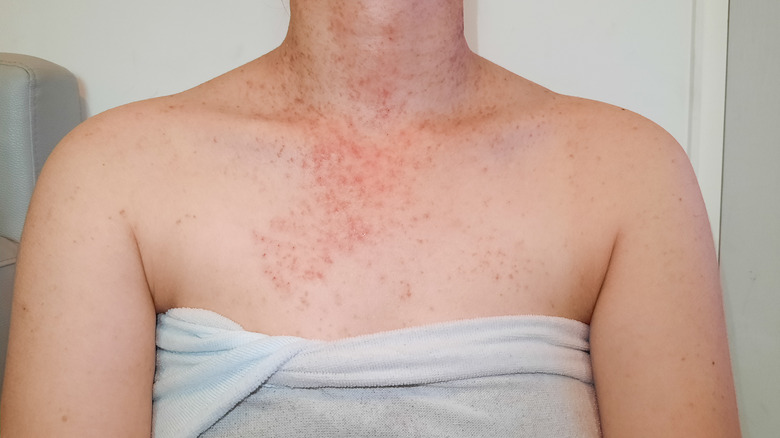Fungal Acne Could Be Responsible For Your Skin Issues
We can all agree that one of the many things from our teenage years we are excited to leave behind is the embarrassment of itchy, red acne. Unfortunately, this isn't always the case, as acne can follow us into our adult years. According to The American Acne Association, 31.9% of adult females and 20.5% of adult males are affected by acne in their adult years.
Acne isn't something anyone wants to deal with, especially as an adult, but acne treatments that work the best can be both expensive and time-consuming. Per RealSelf, a professional chemical peel to combat skin problems can cost you nearly $300 plus subsequent visits to the dermatologist. And if you're still not seeing your acne diminishing even after all the pricey treatments, it can be extremely frustrating.
It's true that some treatments just don't seem to work, but you could be using the wrong type of treatment without even realizing it. Fungal acne is a skin condition that mimics regular acne but requires an entirely different treatment. If you have fungal acne, the treatments you're using could be making your skin condition even worse.
What is fungal acne?
Fungal acne can very easily be misidentified as common acne. Per Cleveland Clinic, the red, itchy bumps that common acne is characterized by is also a common side effect of having fungal acne.
Although fungal acne looks very similar to the common acne we're more familiar with, the key difference is what they're caused by. When bacteria, oil, and dead skin cause blockages in your hair follicles, common acne can occur. You'll notice red and white pimples appearing on your skin. On the other hand, fungal acne is a yeast infection, specifically caused by Malassezia yeast. While fungal acne can also cause pimples to crop up in hair follicles, fungal acne is most likely to show up in specific areas, such as your chest, forehead, neck, and upper arms.
No one wants to have a fungus growing somewhere on their body. However, fungal acne is a fairly common condition that medical experts say is nothing to be ashamed of. According to WebMD, fungal acne is normally brought on by prolonged sweating from exercise, clothing or equipment that is too tight, and skin rubbing against skin.
How is fungal acne treated?
Since fungal acne is caused by a yeast infection and not bacteria, like common acne is, it's important to treat it using different measures. While facial and body acne can usually be treated by spot treatments and other chemicals, anti-fungal treatments are best suited for staving off fungal acne.
Surprisingly enough, your best weapon against fungal acne is using an anti-dandruff or anti-fungal shampoo. In an interview with Marie Claire, board-certified dermatologist Dr. Lindsey Zubritsky explained that the same fungus that causes dandruff is also responsible for fungal acne. She recommends applying the shampoo to your problem areas several times a week, making sure to rinse off within 10 minutes of application. Your treatment shampoo should contain at least one of the following ingredients: zinc pyrithione, selenium sulfide, or ketoconazole.
To prevent a reinfection, Healthline recommends paying close attention to how much you're sweating. Tight clothes that offer little to no airflow and excess sweat are the perfect habitation for yeast growth. If you're just coming in from a jog or a trip to the gym, be sure to hop in the shower. The hot water will wash away any yeast that might be forming on your skin.


